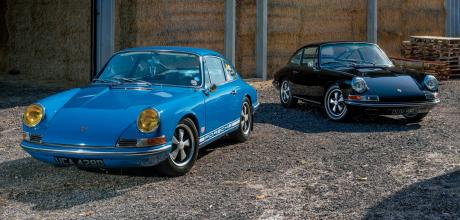Celebrating the brilliance of the Porsche 912
Perceived wisdom suggests the four-cylinder 912 was just a budget 911 — all show, but not a lot of go. Truth is, the 912 comprehensively outsold the 911 during its three-year lifespan, but is only now getting the recognition it so richly deserves...
Words Steve Bennett
Photography Dan Sherwood
BASIC INSTINCT
Celebrating the brilliance of the 912.
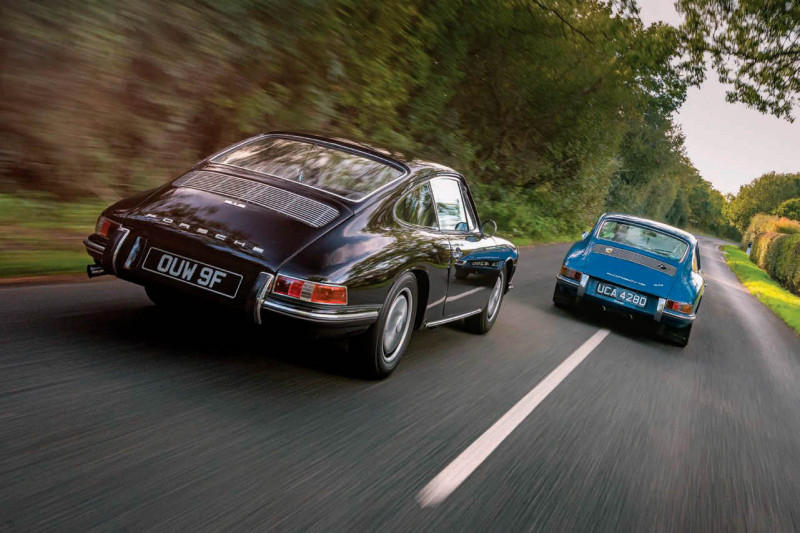
Was the 912 the car that saved the 911? Well, not quite, but it played a vital role in supporting the 911 in its early launch years, when Porschephiles were getting their heads around the huge leap forward the six-cylinder model represented over the outgoing 356. And while that huge leap forward in performance and modernity was obviously welcome, the price was a slightly different matter. The problem? In Germany the ‘old’ 356 1600 SC cost DM16,450, whereas the new 911 was listed at an ambitious DM22,900, almost half as much again. Ouch.
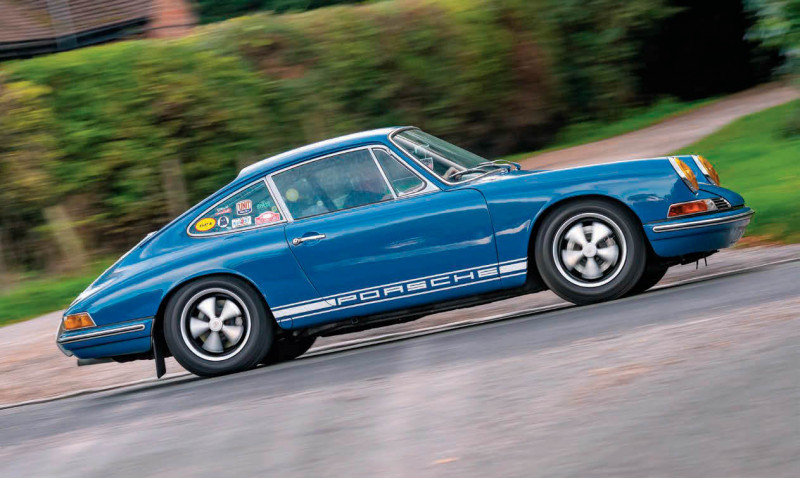
This dramatic increase wasn’t lost on Porsche’s marketing department, aware as always of the company’s humble Volkswagen origins. There needed to be an entry-level event to support the 911, at least while a suitable model range was developed. Enter, then, the 912. For all intents and purposes, it was a four-cylinder ‘budget’ version of the 911, but as we will see, it was also much more.
INTEREST IN THE 912 IS STRONG RIGHT NOW, BOTH FOR ORIGINALITY AND HOT RODDING, TO WHICH THE MODEL LENDS ITSELF
The first entry-level Porsche? A gateway drug, in modern speak. Certainly, but one which would introduce a new audience to the Porsche way of life — buyers who might progress to the brand’s more aspirational/ expensive models. This blueprint has worked miracles for Porsche’s bottom line and image over the years. The 912 set the template for the 914, after all, followed by the 924 and, much later, the Boxster. Huge sellers one and all. And while it’s unlikely Porsche will ever build a contemporary 912, the modern equivalent would be putting the turbocharged B4 flat-four from the 718 Boxster/Cayman twins into a new 911. Food for thought. In this regard, thePorsche 912 was a something of a bargain.
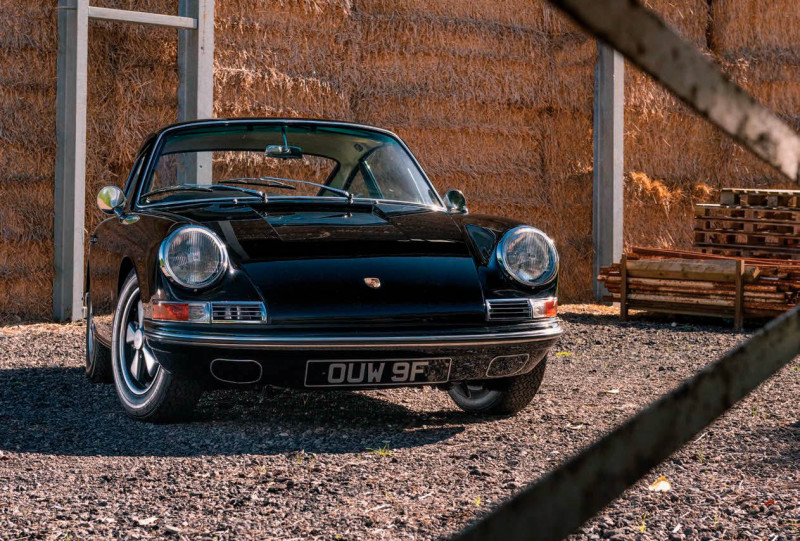
At DM17,000 it was just DM550 more than the outgoing 356 SC, while offering all the style, sophistication and dynamics of the new and substantially more expensive 911. The sacrifice? Two-cylinders, 400cc and 40bhp. While the 911’s new two-litre, quad-cam, 130bhp flat-six provided the sting in the tail, when planning the 912, Porsche pragmatically decided to make use of what it already had in its power unit cupboard, and so installed the 90bhp, OHV flat-four from the 356 SC. Performance figures? The 912 cruises to 60mph in 13.5 seconds, as opposed to the 911’s rather sprightlier 9.1 seconds. Flatout, it’s 115mph versus 130mph.
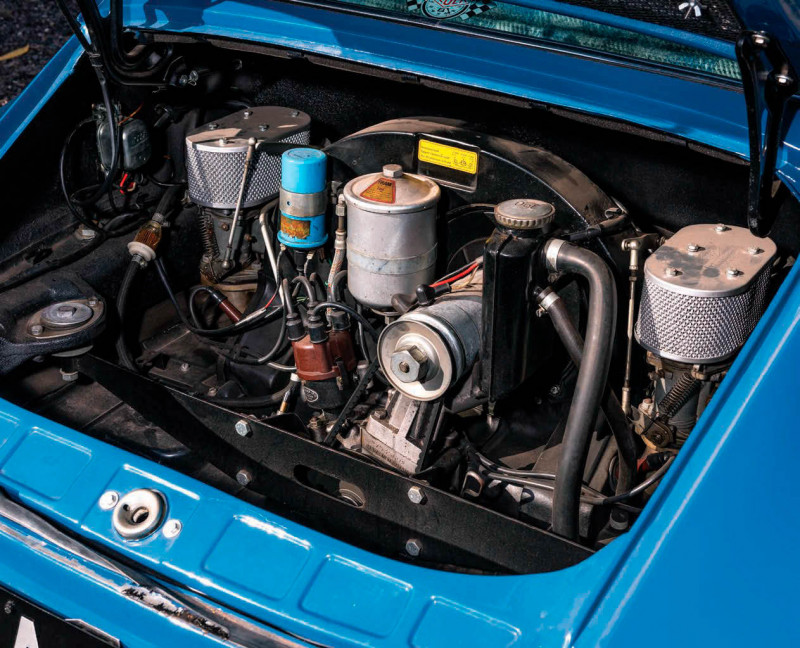
While this might sound like short change in the present, the 912 was a massive and instant success, a fact proved by Porsche’s sales figures. In its first nine months of production — to the end of 1965 — some 6,401 912s were produced, either by Porsche in Stuttgart or the Karmann Karosserie in Osnabrück.
THE CAR WAS DELIVERED TO BRUMOS, A FACT CAPABLE OF EXCITING EVEN THE MOST CASUAL OF PORSCHE ENTHUSIASTS
By way of comparison, just 3,390 911s were sold during the same period. The story was much the same the following year, with 3,730 911s produced against 9,090 912s. It would be 1968 (the final full year of 912 production) before sales of the 911 overtook those of its ‘budget’ brother.
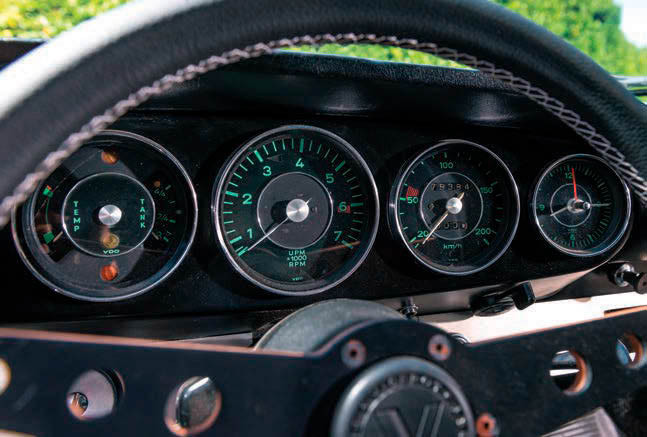
Perhaps, then, it was a case of ‘job done’ for the 912, particularly since the base 911 T was only twenty ponies up on the four-cylinder model, delivering 110bhp from its flat-six.
Was the 912 really that close to the 911? The power sacrifice was a given, but the answer is in the affirmative. Granted, the standard 912 made use of a four-speed version of the 901 gearbox, but many buyers opted for the five-speed unit. Otherwise, it was the very same bodyshell, with the same 2,211mm wheelbase. The same disc brakes and rack-and-pinion steering, too, rather than the 356’s rather vague ZF steering box. Very early 912s had a three-dial dash, but soon adopted the full-five.
Standard rubber floor mats were usually substituted for better-quality, square-weave carpet. Seats were the same flat and bouncy perches found in the 911.
They seem almost comical today — the 911 of the 1960s could never be described as in anyway luxurious. The 912 was no different.
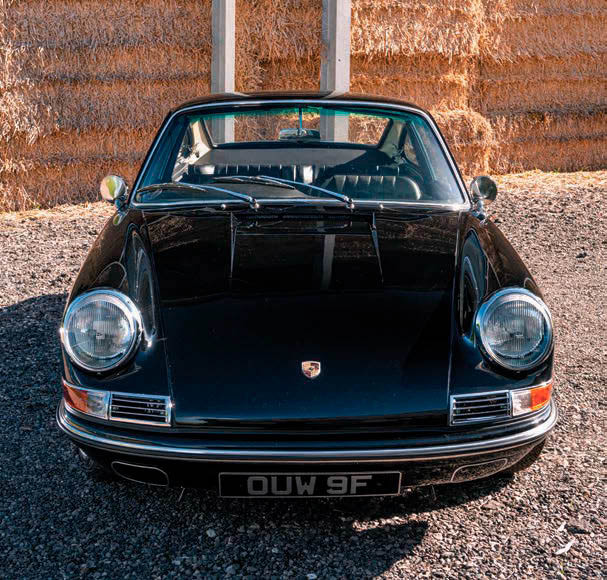
Little surprise the 912 was a massive hit in the North American market, building on California’s passion for the 356, its Speedster variant and a culture ideally suited to the more laidback performance of the ‘baby 911’. In total, some twenty thousand 912s were exported the USA, two-thirds of the entire production run. Volkswagen enthusiasts also took to the 912, it’s flat-four being a direct link to the Beetle’s charismatic off-beat powerplant. And, of course, the 912 was available in Targa form, which suited the West Coast vibe perfectly.
Meanwhile, in grey and drab Blighty, the 912 was a very rare sight indeed, rather like the 911 and the 356 before it. While leftie 912s are relatively plentiful worldwide, a right-of-centre example is a very rare beast. Relatively plentiful, we say? Well, yes, but to qualify this statement, we should point out how the 912 is a substantially rarer machine than its contemporary 911. While both ended up selling in big numbers, the 912 was dramatically culled as it slid down the Porsche food chain. Remember, there was a time when even early 911s were pretty worthless and subject to all sorts of indignities. The same befell the 912, but only worse, to the point these cars were seemingly not worth saving. As you’d expect, US-destined examples fared rather better, which proved useful when the resurgence in 912 interest came around — the North American market stepped in to satisfy demand.
Interest in the 912 is very strong right now, both for originality and hot rodding, to which the model lends itself so well. Not that a 912 is particularly ‘budget’ these days. Those £7,000 cars of twenty years ago are more ‘POA’ today, and it costs as much to restore a 912 as it does a same-age 911. Well, it would really, wouldn’t it?!
Sure, you might save a bit on the engine work, but you’ll be looking at over six-figures to the job properly, even if a nicely presented 912 sourced from America. That’s the current world of the classic Porsche, where there’s absolutely no room for the bodgery of the past and restoration is a hand-crafted artisan pursuit, up there with the finest.
Then again, we know all this, don’t we?! What about the 912 driving experience and the oft talked about weight factor, which gives the 912 a very different feel to the 911? The flat-four is, you see, substantially lighter than the two-litre flat-six. As a consequence, the weight distribution of the 912 is 44/56 front/rear, compared with 41/59 for the 911. Overall, the 912 weighs in at 970kg. Compare this to 1,080kg for an early 911. The difference might not sound significant, but it really does alter driving dynamics.
Modest performance, maybe, but modest weight to punt around. A 912 feels light, too. Perched upright behind the thin-rimmed wheel, progress at first feels vague, but you soon realise the meaty steering associated with later 911s isn’t there. The thinner tyres react immediately to inputs, but thanks to a much reduced footprint and front end weight, the feedback is delicate and detailed, rather than heavy with grip and kick-back from wider rubber. There’s a similar poise to the ride quality — a 912 drifts over broken surfaces, with a deftness coming from a light body, low unsprung weight and tyres with an unfashionable profile.
And the weight balance when compared to a 911? Yes, you do feel it. Light though a 912’s steering maybe in isolation, it’s actually more feelsome than that of a 911, the weight bias of the bigger-engined Porsche making itself known. Likewise, the 912 delivers less of a pronounced swing at the rear. The numbers don’t lie — this four-cylinder Porsche has a balance all of its own. Performance, too. The pushrod flat-four isn’t an engine taking too kindly to being extended, but 90bhp is still meaty enough. Typically, it feels strong in the mid-range, which is exactly where you want your grunt on the road. And, remember, this brilliant boxer only has to propel 970kg. You learn to carry the speed and make the most of the torque. It’s a different kind of progress, not entirely different to contemporary British roadsters (think MGB with a 90bhp pushrod B-series), but with a beat all of its own. Overall, it is more relaxing, more of a cruiser, than a flat-six screamer.
In the end, the 912 just made it to the 1969 model year. With it came an extended wheelbase, achieved by lengthening the rear suspension trailing arms and slightly modifying the rear arches, per the 911. This was Porsche’s first stab at improving the occasionally wayward handling of its cars. Funnily enough, the weight distribution of the 911 was then 43/57 front/rear, making it almost the same as the 912.
BACK FROM THE DEAD
There was a short-lived 912 resurrection in 1976. The subject of another story altogether, the curious case of the G-series 912 E certainly has resonance, conceived once again as an entry-level Porsche to fill the gap between the canned 914 and the not-quite-ready 924. Unlike its predecessor, the 912 E featured not a pukka Porsche engine, but a two-litre Volkswagen flat-four, which previously called the 914 home. And like the original 912, the E-badged variant produced a not especially heady 90bhp. While Porsche might have able to get away with this level of output in 1965, the 912 E was given a sound kicking by just about anyone with an opinion and lasted barely a year in production. Fair? Maybe it’s time to revisit, but not today, for we have two prime examples of early 912 goodness gathered at Rindt Vehicle Design, each car rather neatly representing the two overriding facets of 912 enthusiasm, which is to say the Volkswagen-inspired hot rod vibe and full restoration.
Each of our star cars is dressed in a colour suiting its purpose. Or should that be ‘Sports Purpose’? This is how John McDonald describes the look of his Golf Blau (code 6605 for Porsche paint pervs) beauty.
John is your classic Volkswagen-turned-Porsche fan. As surely as night follows day, he moved from a Beetle to a split panel van, to a 914 and, finally, his dream 912. “I did all the VW shows, including Bug Jam, Run to the Sun and more. There was always a few 356s and Speedsters in attendance, as well as 914s and, of course, the occasional 911. I always had an affinity with the four-cylinder cars, though.”
These days, buying a car takes into consideration vehicles spread across the globe — we now take advantage of a worldwide digital marketplace. John kept an eye on all the machinations of the 912 scene via various platforms, including the very simple expedient of Instagram and the #912 hashtag. “I thought I’d probably missed the 912 boat, but this car came up for sale in Stockholm, Sweden. I’d seen it before. I’d actually ‘liked’ photographs of the car on social media, so it was fitting to see it reappear on Instagram with a note saying it was available for purchase.”
First registered in September 1965, the car was delivered to Brumos Porsche in Florida, a fact capable of exciting even the most casual of Porsche enthusiasts, given the legendary status of the Florida dealership and race team, not to mention the Brumos Porsche museum. Oh, and this 912 is a ‘five on the floor’, as its target US audience would say.
John bought the car back in 2019. “I can’t claim to have had much or any influence on how it looks,” he admits. “Having said that, it looks and is specified just how I wanted it. All credit must really go to Jesse Willstedt.” 912 fans may well have heard of Jesse. He’s renowned in 912 circles and restored John’s car some ten years ago, taking the shell back to bare metal and replacing the floor pans, front suspension pan and attending to any rot, not that there was much to contend with — being from sunny climes, the car’s metalwork wasn’t too bad.
Jesse gave the ’65 a mild hot rod makeover, comprising lowered suspension, Koni shocks, Elephant Racing bushes and six-inch Fuchs. He also treated the car to an engine refresh with valves lapped and shimmed to correct heights. The Solex carbs were serviced with new seals and floats, while the accelerator pumps were set to factory specification. The original 022-dizzy was rebuilt, and a sports exhaust was fitted for a more aggressive noise. This isn’t a concours Porsche and the engine isn’t the original, but none of this matters for a car wearing its patina with pride.
“I knew this was the 912 for me and I knew I needed to get over to Stockholm quickly,” John recalls. “I jumped on to Skyscanner and got a flight for £39. It was almost surreal. I left home on the Wednesday, saw the car on the Thursday and was back at work on the Friday.” He who dares and all that!
“It’s not a fast Porsche, but then again, I don’t want a fast Porsche. When you’ve grown up around air-cooled VWs, then fast isn’t really on the radar! For me, this car is about style. That said, it goes well, but its more than a cruiser. It’s the perfect ‘cars and coffee’ machine, a great excuse to get out and meet other Porsche and VW fans.” Handy that, not least because John runs his own events at the Podium Café in Newbury. Check out his Instagram page (which you can find at @myblue912) for advanced warning of 2023 meets, of which there will be many. In fact, you should get along to the next one, scheduled to take place Sunday 26th February and promising a plethora of air-cooled classics to drool over.
There are plenty of neat touches to his car. We love the hot rod sticker collection on the rear windows and, inside, a Tactico Racing Atelier Viceroy, one of just fifty-nine examples manufactured. Penned by graphic designer, Glenn Cordle, the design caught the eye of Sung Kang, best known for playing the character, Han, in the Fast & Furious movies. Kang helped bring the design to reality exclusively for Tactico. Fitted to a removable boss and individually numbered, the wheel is 380mm in diameter, allowing clear view of the dash gauges in classic Porsche fashion. A laminated white ash back provides warmth and gives the Viceroy a unique look when viewed from different angles, while the rim is expertly trimmed in fullgrain Italian leather with white stitching. It makes a nice change from the usual MOMO Prototipo.
Any future plans? “Not really,” John smiles. “This car is pretty much exactly how I want it. I don’t want concours. Moreover, I wouldn’t use concours. I suppose I’d like some bucket seats on account of the originals being a bit flat and not very comfortable, but otherwise, I’m happy to simply drive and maintain this Porsche as is.”
DIFFERENT STROKES
We get it. This is exactly the sort of 912 we love. Not too precious and perfectly usable. There’s always the other side of the coin, though, which is to reference the other 912 in this dynamic duo. It’s the reason that we have chosen Rindt Vehicle Design to host this 912 tribute. The ‘other side’ is a concours 912. Indeed, it is widely acknowledged as one of the best around. In black and chrome, this four-cylinder stunner is as near perfect as you will ever see a 912 and is just one of many rolling testimonies to the talent on tap at Rindt, something we saw for ourselves when Classic Porsche dropped in to visit the firm’s workshops in advance of the company profile we ran in our December 2022 issue.
Rindt was conceived by former professional golfer and Porsche fanatic, Brian Richardson, and is managed by him and Rindt customer-turned-director, Trevor Ward. These guys oversee an in-house team of professionals that between them can turn a hand to every facet of restoration, modification (including electrification) and race car preparation. Nothing here is outsourced — every stage of every build is accounted for at Rindt’s sprawling Twyford base.
Tellingly, perhaps, of all the classic Porsches the team has built, this 912 is, for Brian, the pinnacle, his favourite. “It is just perfect,” he beams. “It’s my favourite Rindt car and is by far the most talked about. I took it to the Bicester Heritage Scramble in December and people just loved it. Besides, black is the best colour for these early Porsches, even if it is a nightmare to paint.”
Being one of a handful of UK-registered, right-hand drive 912s sold through AFN Chiswick in 1968, it’s a rare Porsche, too. And, amazingly, while it’s easy to think there’s no more barn finds or rarities to be found, this one popped up on eBay. “It was almost scrap,” recalls Brian “It was in boxes and boxes of bits.” Ask whether restoring a 912 is really worth the expense, especially when the car in question is so far gone, and he rightly points out how, in terms of investment and profit, very few restorations are actually worth doing. The heart rules the head. The reward is a car to keep, enjoy and pass on to future generations.
Even so, to a degree, the numbers still need to stack up. Fortunately, the value of air-cooled Porsches in the present means even the worst of the worst is worth saving and, mercifully, all parts are available to do achieve as much. And where an item isn’t listed by Porsche Classic, it can be recreated. “These were hand-built cars, and they still are,” Brian reasons. “Even a genuine Porsche body panel has to be hand-finished into position. There aren’t many old Porsches that haven’t been restored by now. Those that haven’t are all likely to be in pretty poor shape, even if they hail from the West Coast of America.”
Back to black. This is pretty much a standard 912, right down to the four-speed gearbox, save for a few choice customer requests. Full Connolly leather, green dials and silver badges stand out, as opposed to the more blingy gold body decoration of the same-age 911. Better braking materials make a big difference, while more recently, the engine has been gently and sympathetically tweaked. “We rebuilt the flat-four with new pistons, bigger valves and bigger downdraught Webers. It’s more peppy now, with improved drivability, but it’s important to note these cars aren’t really about power. A 912 is just a lovely, relaxed Porsche to drive.”
While John represents the Volkswagen-to-Porsche hot rod connection, Brian and Trevor at Rindt are seeing, perhaps, a different kind of customer through their doors. “We’re getting a lot of classic 911 owners asking about 912s,” Trevor confirms. “Today’s marque enthusiasts see the 912 as a very much part of the 911 story. And, of course, there’s the 356 connection.”
As for all the barn finds and unrestored cars drying up, the Rindt team has just discovered another right-hand drive 912. “It’s waiting for a customer to come along and commission a restoration,” Trevor reveals, inviting us to take the plunge. Whoever ends up with this car, they certainly won’t be disappointed — the 912 deserves its moment in the sun, a reappraisal, if you like.
Ask most folk about the model’s position in the Porsche pantheon and the concept of a four-cylinder 911 lookalike, we’re pretty sure the response would be a shrug and something along the lines of ‘poor man’s 911’, but know this: the 912’s star shone bright and did its bit to smooth the path of the early 911, while comprehensively outselling it along the way. Hardly the underdog.
AS FOR ALL THE BARN FINDS DRYING UP, THE RINDT TEAM HAS JUST DISCOVERED ANOTHER RIGHT-HAND DRIVE 912
Above Mildly modified or standard specification? Which 912 would you be driving home? Above Four-cylinder boxer has been rebuilt and has consequently regained poke. Facing page and below Brian says this 912 is his favourite Rindt Vehicle Design restoration and is the one customers talk about more than any other of the firm’s recently finished projects.
THERE’S ALWAYS THE OTHER SIDE OF THE COIN, WHICH IS TO REFERENCE THE OTHER 912 IN THIS DYNAMIC DUO
Above Classic black-on-black is a superb finish for this immaculately restored 912, though Rindt Vehicle Design head, Brian Richardson, confirms black it isn’t the easiest colour to paint.
Above John organises regular Porsche meets at the Podium Café in Newbury — check out his Insta feed at @myblue912 to find out when the next gathering is taking place Below Ride height was lowered as part of a suspension makeover.
Above Rebuilt flat-four gives plenty of poke for twisty British back roads.
Above and below Tactico Racing Atelier Viceroy steering wheel may be one of only fifty-nine examples made, but it is the second to grace a Classic Porsche feature car in recent months.


